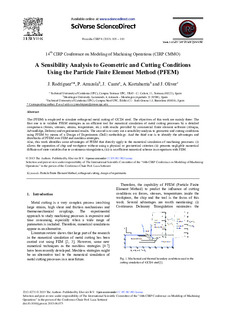Izenburua
A sensibility analysis to geometric and cutting conditions using the particle finite element method (PFEM)Argitalpen data
2013Beste erakundeak
Universitat Politècnica de Catalunya (UPC)Bertsioa
Bertsio argitaratuaDokumentu-mota
ArtikuluaArtikuluaHizkuntza
IngelesaEskubideak
© 2013 The AuthorsSarbidea
Sarbide irekiaArgitaratzailearen bertsioa
http://dx.doi.org/10.1016/j.procir.2013.06.073Non argitaratua
Procedia CIRP Vol. 8. Pp. 105–110, 2013Argitaratzailea
ElsevierGako-hitzak
Particle Finite Element MethodOrthogonal cutting
Design of experiments
Laburpena
The (PFEM) is employed to simulate orthogonal metal cutting of 42CD4 steel. The objectives of this work are mainly three: The first one is to validate PFEM strategies as an efficient tool for numerica ... [+]
The (PFEM) is employed to simulate orthogonal metal cutting of 42CD4 steel. The objectives of this work are mainly three: The first one is to validate PFEM strategies as an efficient tool for numerical simulation of metal cutting processes by a detailed comparison (forces, stresses, strains, temperature, etc.) with results provided by commercial finite element software (Abaqus, AdvantEdge, Deform) and experimental results. The second is to carry out a sensibility analysis to geometric and cutting conditions using PFEM by means of a Design of Experiments (DoE) methodology. And the third one is to identify the advantages and drawbacks of PFEM over FEM and meshless strategies.
Also, this work identifies some advantages of PFEM that directly apply to the numerical simulation of machining processes: (i) allows the separation of chip and workpiece without using a physical or geometrical criterion (ii) presents negligible numerical diffusion of state variables due to continuous triangulation, (iii) is an efficient numerical scheme in comparison with FEM. [-]
Bildumak
Item honek honako baimen-fitxategi hauek dauzka asoziatuta:






















